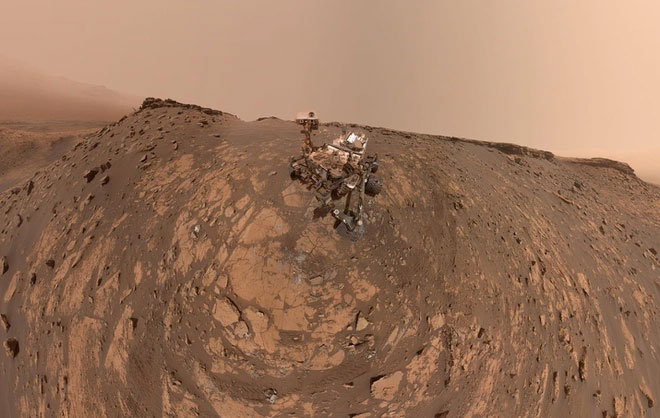Found a place where there is no radiation on Mars, people can take shelter
Mars does not have a magnetic shield and a thick atmosphere like Earth, so it is possible for radiation to hit the surface. However, recently scientists have found some places on Mars that can "dodge" radiation.
For humans, radiation is a deadly danger. How can adventurers deal with that? They will need a shelter and they will have to bring it with them a special tool or build on Mars somehow. Or natural features can be used as part of a protective measure.
A new study using data from the Curiosity Mars Science Laboratory (MSL) has discovered several possible shelters from radiation.
When MSL Curiosity landed on the surface of Mars in 2012, it was carrying an instrument called the Radiation Assessment Detector (RAD).

RAD data show that near the Murray Buttes region, the radiation dose is reduced by about 5%.
RAD prepares for future human visits to Mars. It detects and measures harmful radiation on Mars emitted by the Sun and other sources. It can also assess the danger that radiation poses to any microbial life that may exist on Mars. The RAD is about the size of a toaster and sits discreetly on the top surface of the Curiosity.
One of the MSL regions studied with RAD is the Murray Buttes region . The Murray Buttes region is located on the summit of Mount Sharp lower in Gale Crater.
Curiosity mainly studies geology, especially sandstone features, and a type of layering known as the "cross buffer". In addition, RAD continues to collect data. That data shows a drop in surface radiation.
RAD data show that near the Murray Buttes region, the radiation dose is reduced by about 5%. The team also built a sky visibility map, showing that 19 percent of the sky was obscured when the pilot was in the vicinity of the Murray Buttes region. This is very important data.
When driving through the Murray Buttes area, Curiosity was unobstructed to the sky due to topographical features. So the team built a panoramic view of the sky from an average taken over the previous few months to compare with the collected data.
The scientists also discovered that the same surface features that can protect from direct radiation can also increase reflected radiation. RAD has shown that the Murray Buttes region can produce an increase in secondary reflected radiation. That's one of the complexities about understanding radiation on Mars. Radiation on the Martian surface is not consistent, but fluctuating.
Mars' orbit changes its distance from the Sun, which also affects surface radiation. Lower altitudes will experience less radiation than higher altitudes. Radiation is not a homogeneous phenomenon: There are protons, alpha particles, ions of different elements, neutrons, and gamma rays.
This study helps paint a more complete picture of the radiation environment on Mars. There is a lot of thought put into using the resources in place on the Red Planet. Shelter is a key need for Mars explorers, and if an advantage can be gained using existing terrain features for protection, then those features would be well suited to missions. Future.
There's been a lot of talk about placing bases in lava tubes, where humans would be protected by meters of regolith on Mars. But the astronauts couldn't spend all their time there. They will have to be exposed to radiation.
Any mission to Mars that involves humans will need layers and layers of redundancy. In the event of an emergency, it is paramount to keep the astronauts' radiation dose as low as possible.
- People withstand radiation on Mars
- This will be the base of humanity in the mission of exploding Mars ahead
- Radiation is deadly in the Martian mission
- Facing death, many people still want to go to Mars
- Humans can survive on Mars
- People who survive on Mars can evolve into new species
- How will the first man on Mars die?
- If the zombie epidemic happens, what is the safest shelter? Statisticians have the answer!
- 8 smart shelter houses
- Mars travelers must use feces to cover the spacecraft
- Elon Musk wants to bomb Mars, turning into a place where people can stay
- New discoveries are making NASA's hopes of conquering Mars difficult to succeed
 Announced 3 houses on the Moon and Mars
Announced 3 houses on the Moon and Mars Science proves: Mars also knows 'deflated'
Science proves: Mars also knows 'deflated' Elon Musk announced the price for a Mars trip was 11.6 billion VND, free of charge
Elon Musk announced the price for a Mars trip was 11.6 billion VND, free of charge NASA discovered strange 'gate' on Mars, is the hiding place found?
NASA discovered strange 'gate' on Mars, is the hiding place found? First discovery of life-preserving magnetosphere outside the Solar System
First discovery of life-preserving magnetosphere outside the Solar System  Close-up of the process of 'making' cancer radiation therapy masks
Close-up of the process of 'making' cancer radiation therapy masks  New species of water bear reveals the secret of immortality
New species of water bear reveals the secret of immortality  Device for generating electricity at night from infrared radiation
Device for generating electricity at night from infrared radiation  Wild 'paradise' nearly 40 years after the Chernobyl nuclear disaster
Wild 'paradise' nearly 40 years after the Chernobyl nuclear disaster  If we want to live on Mars, why do humans need to breed with creatures that have existed on Earth for 530 million years?
If we want to live on Mars, why do humans need to breed with creatures that have existed on Earth for 530 million years? 